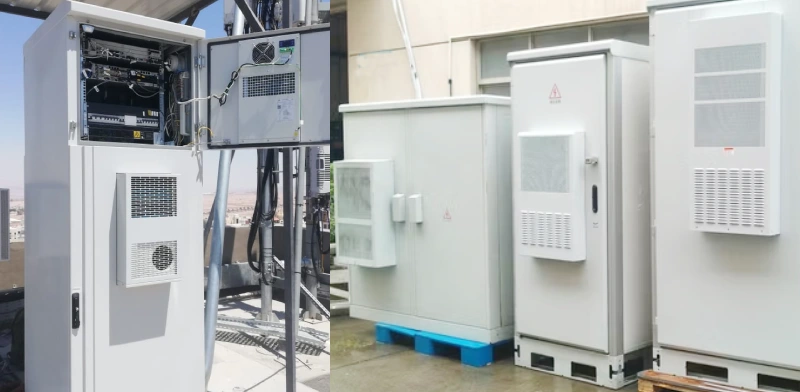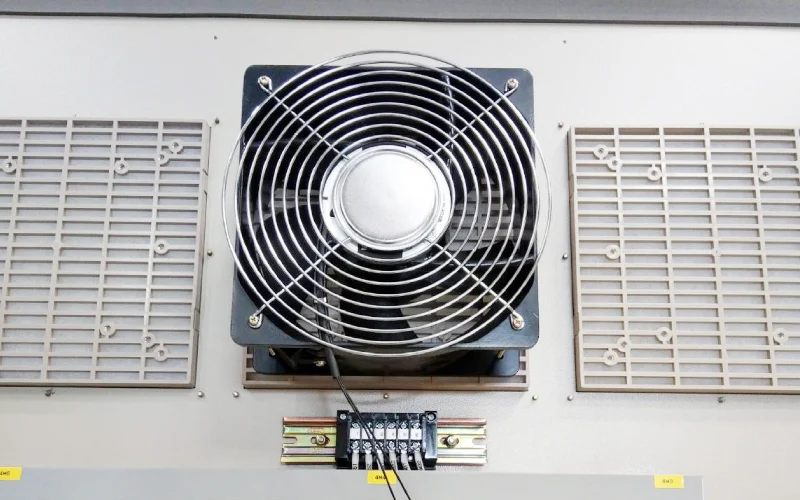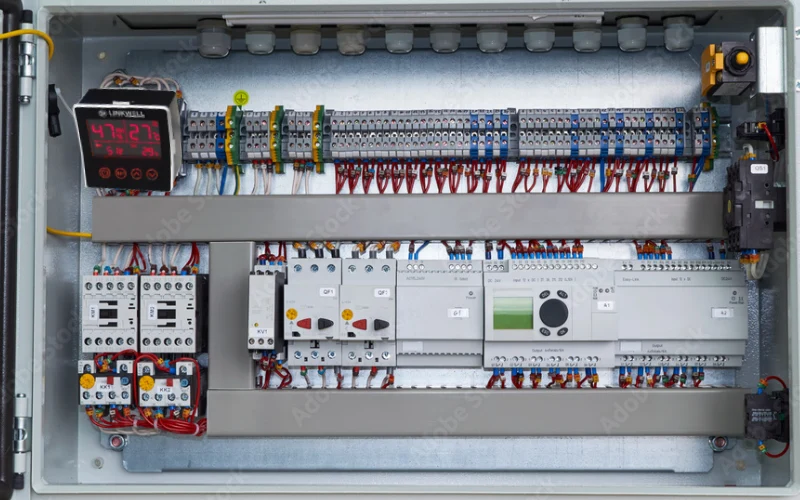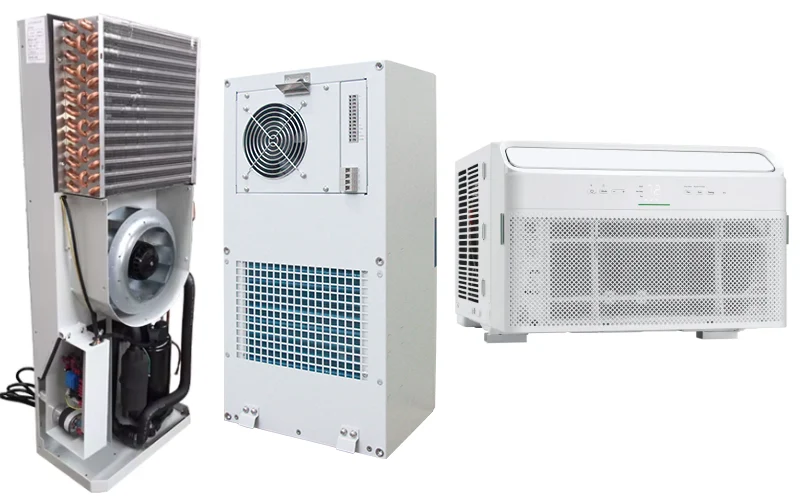You want the best cooling for your cabinet, but deciding between a dc or ac cabinet air conditioner can feel tricky. Your needs matter most. You might focus on energy savings, reliability, or how the air conditioner fits with your setup. Cabinet air conditioners use air to protect sensitive electronics and keep things running smoothly. Energy efficiency, air flow, and cabinet compatibility all play a role. Linkwell offers both DC and AC cabinet air conditioner models, so you always get a solution that matches your needs.
Key Takeaways
- DC cabinet air conditioners are ideal for off-grid setups, using battery banks or solar panels. They offer energy efficiency and flexibility in power sources.
- AC cabinet air conditioners work best in environments with stable grid power. They provide strong cooling performance for hospitals, factories, and data centers.
- Regular maintenance is crucial for both DC and AC models. Monthly checks can reduce energy use and extend the life of your air conditioner.
- Choose the right cooling capacity for your cabinet. Both DC and AC models range from 300W to 5000W, ensuring you find the perfect fit for your needs.
- Linkwell offers both DC and AC options, allowing you to select the best air conditioner based on your specific power source and environmental conditions.
DC or AC Cabinet Air Conditioner: Key Differences

Choosing between a dc or ac cabinet air conditioner can feel overwhelming. You want to keep your cabinet cool, but you also need to think about how each type fits your setup. Let’s break down the key differences so you can make the best choice for your application. Linkwell offers both dc cabinet air conditioners and ac cabinet air conditioners, giving you flexibility no matter your needs.
How DC and AC Work
You might wonder how dc and ac cabinet air conditioners actually work. DC cabinet air conditioners use direct current (DC) to power the cooling system. This means the air conditioner connects easily to battery banks, solar panels, or other DC power sources. You often see dc cabinet air conditioners in places where stable, low-voltage power is available or preferred.
AC cabinet air conditioners run on alternating current (AC). These units plug into standard electrical outlets or industrial power supplies. AC cabinet air conditioners work well in environments with reliable grid power. You get strong cooling performance and easy integration with existing electrical systems.
Both types use fans and compressors to move air and control temperature inside the cabinet. The main difference is the power source. DC models suit off-grid or mobile setups. AC models fit stationary installations with consistent power.
Typical Applications
You want your cabinet air conditioner to match your environment. DC cabinet air conditioners shine in specialized settings. Here’s a quick look at where you’ll find them:
| Application Area | Description |
|---|---|
| Electrical Control Box | Used for temperature control in electrical systems |
| Communication Industry | Applicable in mobile base stations and outdoor cabinets |
| Data Processing Box | Ensures optimal conditions for data handling equipment |
| Heavy Motor Equipment Control Box | Maintains necessary temperature for heavy machinery |
| Subway and Railway Systems | Provides cooling solutions for outdoor installations |
You see dc cabinet air conditioners in electrical control boxes, communication cabinets, and railway systems. These places often rely on DC power and need reliable air cooling to protect sensitive electronics.
AC cabinet air conditioners appear in a wide range of environments. You’ll notice their popularity growing in South and Southeast Asia, especially in urban areas and hospitals. Rising temperatures and increased energy use in buildings drive the demand for ac cabinet air conditioners. You find them in:
- Hospitals and healthcare facilities
- Urban commercial buildings
- Industrial sites with stable grid power
- Data centers and server rooms
AC cabinet air conditioners handle high cooling loads and work well in places with strong electrical infrastructure. You get dependable air conditioning for cabinets in busy, high-temperature environments.
When you compare dc or ac cabinet air conditioner options, think about your power source, location, and cooling needs. Linkwell’s product range covers both, so you can pick the right air conditioner for your cabinet and application.
Energy Efficiency
Power Consumption
When you look at energy efficiency, you want your cabinet air conditioner to deliver strong cooling without wasting energy. DC cabinet air conditioners stand out for their energy-saving design. These units use direct current, which means they work well in places with limited power. You often see dc models in energy-efficient data centers or remote sites where every bit of energy counts.
- AC cabinet air conditioners usually consume more energy than dc models. They rely on alternating current, which is less efficient for long-term cooling.
- DC air conditioners use inverter compressors. These adjust their speed based on the cooling needs inside your cabinet. This feature cuts down on energy waste and helps you save money.
- If you want high efficiency models, dc cabinet air conditioners offer a smart choice for energy-efficient solutions.
You get reliable cooling performance with both types, but dc units give you an edge in energy efficiency. This matters a lot in energy-efficient data centers or off-grid setups where power is precious.
Operational Costs
You want to keep your operational costs low while getting the best cooling performance. The type of cabinet air conditioner you choose affects your long-term expenses. AC cabinet air conditioners and dc models both need regular care to keep their performance high.
Tip: Regular maintenance is key! Cleaning filters, checking refrigerant, and keeping coils clean can reduce energy use by up to 25%. Neglecting these tasks can lead to higher bills and more repairs.
- About 85% of HVAC repairs come from poor maintenance.
- Routine care can cut breakdown risk by up to 95% and extend your system’s life by up to 50%.
If you stay on top of maintenance, your cabinet air conditioner will deliver steady cooling and strong performance. You’ll also enjoy lower energy bills and fewer headaches. Whether you pick ac or dc, good habits help you get the most from your air conditioner and keep your cabinet running cool.
Performance and Cooling
Cooling Capacity
You want your cabinet to stay cool, no matter how tough the job gets. Cooling capacity tells you how much heat your air conditioner can remove from the cabinet. Both dc and ac cabinet air conditioners offer strong cooling performance. You might wonder if one type gives you more cooling power than the other. The truth is, both types cover a similar range.
Here’s a quick look at the cooling capacity ranges:
| Type of Air Conditioner | Cooling Capacity Range |
|---|---|
| DC Cabinet Air Conditioner | 300W to 5000W |
| AC Models | Similar range |
You can find dc cabinet air conditioners with cooling capacity as low as 300W for small enclosures. AC cabinet air conditioners also start at 300W and go up to 5000W for bigger cabinets. This means you get flexibility for different environments and cabinet sizes. If you need high cooling capacity for a large cabinet, both dc and ac models can deliver. You don’t have to worry about sacrificing performance or energy efficiency. You get reliable cooling and strong performance, whether you choose dc or ac.
Tip: Always check the cooling capacity before you buy. The right cooling capacity keeps your cabinet safe and your electronics running smoothly.
Environmental Suitability
You want your cabinet air conditioner to work well in any environment. DC cabinet air conditioners shine in places with unstable power or off-grid setups. You see them in outdoor environments, remote telecom cabinets, and solar-powered systems. These units handle tough conditions and keep your cabinet cool even when energy is limited.
AC cabinet air conditioners fit environments with steady grid power. You find them in hospitals, factories, and urban buildings. These models offer high cooling capacity and strong performance in busy environments. AC cabinet air conditioners work well in places with high temperatures and heavy workloads.
Both dc and ac cabinet air conditioners use advanced technology to boost energy efficiency. You get inverter compressors and smart controls that adjust cooling capacity based on the environment. This means you save energy and keep your cabinet at the right temperature. You get reliable cooling performance, no matter where you install your air conditioner.
Note: Always match your cabinet air conditioner to your environment. The right choice gives you better energy efficiency, cooling capacity, and performance.
Compatibility and Integration
Power Source Needs
You want your cabinet air conditioner to work with your existing power setup. The type of power you have makes a big difference. DC cabinet air conditioners run on dc power. You see options like 12 VDC, 24 VDC, 48 VDC, and even 250 VDC. These choices let you connect your air conditioner to battery banks, solar panels, or other dc power sources. If you work in remote areas or use renewable energy, dc cabinet air conditioners give you flexibility.
AC cabinet air conditioners use ac power. You find models that work with 120 VAC, 240 VAC, and three-phase options. These air conditioners plug into standard outlets or industrial power supplies. If your site has reliable ac power, you get easy installation and strong performance. AC cabinet air conditioners fit well in factories, hospitals, and urban buildings.
Here’s a quick look at the power source options:
| Type of Air Conditioner | Power Source Options |
|---|---|
| DC | 12 VDC, 24 VDC, 48 VDC, 250 VDC |
| AC | 120 VAC, 240 VAC, Three-phase options |
You need to match your cabinet air conditioner to your available power. DC power works best for off-grid setups. AC power suits places with steady electricity. The right choice helps you save energy and boost efficiency.
System Integration
You want your cabinet air conditioner to fit smoothly into your system. DC cabinet air conditioners connect easily to setups that use dc power. You see them in telecom cabinets, solar-powered stations, and mobile equipment. These air conditioners help you keep energy use low and maintain efficiency.
AC cabinet air conditioners work well with operating hvac systems in large buildings. You can link them to existing ac power lines and control systems. This makes integration simple. You get reliable air cooling and strong performance.
If you need remote monitoring, both dc and ac cabinet air conditioners offer smart controls. You can adjust temperature, check energy use, and get alerts. This helps you manage your cabinet and protect sensitive electronics. You keep your air conditioner running smoothly and avoid downtime.
Tip: Always check your power source before you choose a cabinet air conditioner. The right match saves energy and keeps your system efficient.
Cost Factors
Purchase Price
You want to know how much you’ll spend on a cabinet air conditioner. The purchase price depends on the type you choose. DC cabinet air conditioners usually cost more upfront than AC models. You pay for advanced technology and the ability to connect to different power sources. If you need a unit for a remote site or a solar-powered system, a dc air conditioner gives you flexibility. AC cabinet air conditioners often have a lower initial price. You can plug them into standard power outlets, which makes installation easy.
Here’s a quick table to help you compare:
| Type | Typical Purchase Price | Power Source Flexibility |
|---|---|---|
| DC Cabinet Air Conditioner | Higher | High |
| AC Cabinet Air Conditioner | Lower | Standard |
You should think about your budget and your power needs. If you want to save money at the start, ac cabinet air conditioners might be the way to go. If you need more options for power, dc models offer better efficiency and adaptability.
Maintenance
You want your cabinet air conditioner to last. Regular maintenance helps you get the most out of your investment. Both dc and ac cabinet air conditioners need care to keep air flowing and cooling strong. You should clean filters, check for dust, and inspect the unit for leaks. If you ignore maintenance, you risk losing efficiency and spending more on energy.
Tip: Set a reminder to check your cabinet air conditioner every month. Clean filters and look for signs of wear. This simple step saves you money and keeps your air conditioner working well.
DC cabinet air conditioners often have fewer moving parts. You might spend less time on repairs. AC cabinet air conditioners are easy to service because parts are widely available. No matter which type you choose, good maintenance keeps your cabinet cool and protects your electronics from heat and power issues.
Reliability and Maintenance
Service Life
You want your cabinet air conditioner to last as long as possible. Longevity matters, especially when you rely on your cooling system to protect sensitive electronics. DC cabinet air conditioners stand out for their impressive service life. You can expect these units to keep working for over a decade. That means less worry about replacements and fewer interruptions to your operations.
- DC cabinet air conditioners typically have a service life of over 10 years.
- AC cabinet air conditioners also offer reliable performance, but their lifespan often matches the demands of environments with frequent use.
You might notice that DC models use fewer moving parts. This design helps reduce wear and tear. You get a cooling solution that stays dependable year after year. AC models perform well in busy settings, but you may need to check them more often if your environment is harsh or the workload is heavy.
Tip: Regular maintenance helps you extend the life of both DC and AC cabinet air conditioners. Clean filters and inspect components to keep your unit running smoothly.
Downtime
Nobody likes unexpected downtime. You want your cabinet air conditioner to work without interruptions. DC cabinet air conditioners shine in environments where reliability is critical. Their robust design means you spend less time worrying about breakdowns. You get consistent cooling, which keeps your electronics safe and your operations on track.
AC cabinet air conditioners also deliver steady performance. You find them in places with stable power and high cooling demands. If you follow a good maintenance routine, you can minimize downtime for both types. Quick filter changes and regular inspections make a big difference.
Here’s what you can do to keep downtime low:
- Schedule monthly checks for your cabinet air conditioner.
- Replace filters and clean coils as needed.
- Watch for signs of wear or leaks.
You stay ahead of problems and keep your system reliable. Whether you choose DC or AC, Linkwell’s cabinet air conditioners help you maintain a cool, safe environment for your equipment. Reliable cooling means fewer headaches and more peace of mind.
Linkwell Cabinet Air Conditioner Features

Product Advantages
You want cabinet air conditioner features that make your job easier and your equipment safer. Linkwell gives you just that. You get high-grade filtration and IP-rated protection against dust and water. These features keep your cabinet clean and dry, even in tough conditions. Smart digital controls let you monitor temperature and get alerts if something changes. You stay in control and avoid surprises.
Linkwell uses military-grade materials and brushless motors. These features boost durability and help your air conditioner last longer. You notice low noise and low maintenance. You spend less time worrying about repairs and more time focusing on your work. Flexible options for customization mean you can pick features that fit your location or budget.
- High-grade filtration and IP-rated protection
- Smart digital controls for temperature monitoring
- Military-grade materials and brushless motors
- Low noise and low maintenance
- Flexible customization options
Linkwell designs cooling systems with advanced features like inverter compressors and EC fans. These features help you save energy and keep your cabinet cool. You find these air conditioner features in industrial plants, telecom sites, and off-grid solar projects. You get reliable performance and long-term value.
Customer feedback shows that Linkwell cabinet air conditioner features support stable performance in harsh outdoor conditions. You can trust these features to protect your equipment and keep your business running.
Certifications and Standards
You want cabinet air conditioner features that meet global standards. Linkwell delivers. You get products with UL, CE, and ISO certifications. These features prove that your air conditioner meets strict safety and quality rules.
| Certification/Standard | Description |
|---|---|
| IEC 60529 | Compliance for dust and water resistance (IP66/IP67) |
| UL 60529 | Compliance for dust and water resistance (IP66/IP67) |
| NEMA 4X | Suitable for harsh environments |
| CE | European safety standard |
| ISO | International standard for quality management systems |
These features make Linkwell cabinet air conditioners ready for use in hospitals, factories, telecom stations, and outdoor sites. You get peace of mind knowing your air conditioner features meet the highest standards. You can install your cabinet air conditioner anywhere and trust its features to perform.
Choosing the Right AC Cabinet Air Conditioners
You want the best cooling for your cabinet, but you might wonder if dc or ac cabinet air conditioner models fit your needs better. The answer depends on your setup, your power source, and the kind of equipment you need to protect. Let’s look at when you should choose dc cabinet air conditioners and when ac cabinet air conditioners make more sense.
When to Choose DC
You should pick dc cabinet air conditioners when your needs call for flexible power options, high energy efficiency, or reliable cooling in tough spots. DC models work great in places where you do not have steady grid power. You might use battery banks, solar panels, or other dc sources. These air conditioners keep your equipment safe and cool, even when energy is limited.
Here are some practical scenarios where dc cabinet air conditioners shine:
| Application Area | Use Case Description | Equipment Protected |
|---|---|---|
| Industrial Control Cabinets | Prevent overheating in factory control panels | Control panels, PLCs |
| Telecom Enclosures | Maintain optimal temperature for network gear | Routers, switches |
| Battery Storage Boxes | Extend battery life by preventing heat damage | Lithium and lead-acid batteries |
| Laboratory Equipment Cabinets | Maintain stable temperature for experiments | Instruments, chemicals |
| Outdoor Electrical Panels | Protect electrical circuits from sun and weather | Electrical circuits |
You might run a telecom site in a remote area. You need stable cooling for routers and switches, but you only have dc power. DC cabinet air conditioners solve this problem. Maybe you manage battery storage for solar homes. You want to keep batteries cool and extend their life. DC models help you do that with less energy use.
If you work in a factory, you know control panels and PLCs can get hot fast. DC cabinet air conditioners prevent overheating and keep your operations running. You also see these units in outdoor electrical panels. They protect circuits from heat and weather, which is key for homes and businesses in sunny or harsh climates.
Tip: If your needs include off-grid power, solar energy, or mobile setups, dc cabinet air conditioners give you the flexibility and efficiency you want.
When to Choose AC
You should choose ac cabinet air conditioners when your needs include steady grid power, high cooling capacity, or large-scale installations. AC models fit well in places like hospitals, factories, and commercial buildings. You get strong cooling for cabinets that protect sensitive electronics in busy environments.
Here’s a step-by-step guide to help you pick the right ac cabinet air conditioner for your needs:
- Calculate the total heat load in your cabinet. Check the power loss for each device.
- Decide the lowest safe temperature for your equipment. Pick a target temperature that keeps your gear safe.
- Look at the ambient temperature. High outside temperatures mean you need more cooling capacity.
- Use a BTUH calculator to figure out the exact cooling capacity you need.
- Don’t pick a unit that’s too big. Oversized air conditioners cycle too much and wear out faster.
- Don’t go too small either. Undersized units can’t keep up with your cooling needs.
- If you’re not sure, talk to a specialist. Linkwell’s team can help you size and select the right model.
You might run a data center in a city. You need reliable cooling for server cabinets and steady ac power is available. AC cabinet air conditioners handle the load and keep your systems safe. Maybe you manage a hospital or a large office. You want to protect sensitive electronics and keep air flowing in every cabinet. AC models give you the cooling capacity and easy integration you need.
Note: For homes or businesses with stable electricity, ac cabinet air conditioners offer simple installation and strong performance. You get peace of mind knowing your equipment stays cool, even during busy times.
Linkwell understands your needs. The company offers both dc and ac cabinet air conditioner solutions. You get options for every scenario, from solar-powered homes to high-tech factories. Linkwell’s cooling systems protect your equipment, save energy, and fit your budget. If you face harsh weather or high heat, dc cabinet air conditioners are a smart choice. For indoor or mild outdoor conditions, you might use a fan filter unit or an ac model.
You know your needs best. Think about your power source, your environment, and the equipment you want to protect. With Linkwell, you always find a cabinet air conditioner that matches your needs and keeps your operations running smoothly.
Choosing between a dc or ac cabinet air conditioner comes down to your power source, environment, and the size of your cabinet. You get closed-loop systems for dirty spaces, open-loop for clean air, and split systems for bigger cabinets. Cooling capacity ranges from 300W up to 17.5kW, so you always find the right fit. Recent trends show compact air conditioners and energy-saving features make dc models a smart pick for efficient cooling. Linkwell helps you pick the best air conditioner for your needs, offers custom settings, and supports you with quick quotes and installation help. If you want a reliable air solution, reach out to Linkwell for expert advice.
FAQ
What size cabinet air conditioner do I need?
You need to match the cooling capacity to your cabinet’s heat load. Check your equipment’s power loss and use a thermal load calculator. If you’re unsure, Linkwell’s team can help you pick the right size for your setup.
Can I use a DC cabinet air conditioner with solar panels?
Yes, you can! DC cabinet air conditioners work great with solar panels and battery banks. They give you reliable cooling in off-grid or remote locations. You get energy savings and flexibility for your power source.
How often should I maintain my cabinet air conditioner?
You should check filters and clean them every month. Inspect for dust, leaks, or wear. Regular maintenance keeps your unit running smoothly and helps prevent breakdowns.
Tip: Set a calendar reminder for monthly checks. This simple habit can extend your air conditioner’s life.
What certifications do Linkwell cabinet air conditioners have?
Linkwell cabinet air conditioners meet global standards. Here’s a quick look:
| Certification | What It Means |
|---|---|
| UL, CE | Safety and compliance |
| ISO | Quality management |
| IP54/IP65 | Dust and water protection |
You can trust these certifications for safe and reliable operation.




